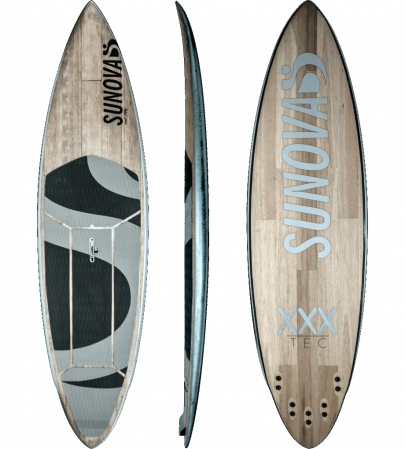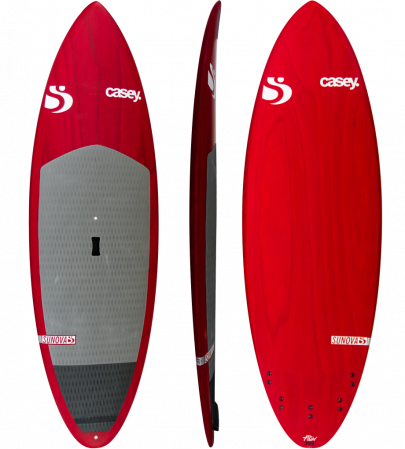OUTLINE
Sleek clean outline, flyer, pintail. In juicy waves, the biggest priority is firstly making the drop. Having a narrower nose in certain cases means less paddle power, however having less nose area does not catch the wind, so there’s less chance of digging a rail at the bottom. The narrower nose blends into a straighter clean curve which carries speed well while the rail is engaged or you’re drawing a line around a section. The flyer helps to break that drawn outline and allow you to tighten up a turn, square off and pull into a tighter part of the wave or snap under the lip at speed. As you step back onto the pin you can either wash off speed for a stall or attack sections with confidence, knowing the tail will bite and hold.
RAILS
Low rail with a distinctly tucked under edge that carries past the flyer. A low rail is just so much more sensitive when surfing. When you initiate a turn, the first thing you do is bury one rail, if that rail is thick and boxy, you’re trying to fight it into the water, the faster you go, the harder it is to bury a thick rail because you’re working against both buoyancy and the flow of oncoming water. The bottom edge is really tucked under, with less hard edge than you would find on most other boards in the tail. This helps with really late drops, the type where you’re almost falling out of the lip. A hard edge, in this case, has more release, so at the point on the face where the board wants to engage and stick, it doesn’t, it will drift a little, potentially placing you under a falling lip. But the tucked under edge, holds the face really well (like an old school log), if it’s a free fall, it will grab the face at the very point you land, letting you ease in while holding a higher line and keeping you out of trouble. Only in the last 6” of the tail does the edge finally get hard and refined, but also with the apex at the bottom edge, with the tail rail being so fine it slices through the water with ease at high speed.
ROCKER
Full performance rocker. A clean even curve all the way through. Feed it power and you have control even in the tightest parts of the wave. It loves to stick the latest drops, attack sections tight at speed and it feels really comfortable in the bowl.
BOTTOM
Flat upfront blending into a single concave through the middle, to a double concave into the back foot and subtle V on the exit. The concave upfront helps initiate a turn earlier, keeps the board responsive, as your rail will engage the second your mind decides to. We have purposely kept the concave out of the nose, this is to reduce over sensitivity and keep the front rail higher out of the water. At speed, if your front rail engages when you don’t want it to, it can throw you off or into a spin. The double concave then creates a spine where the stringer would be but also allows the transition into the subtle V to be smoother. This subtle V kicks in when you are right on the back foot, when somewhere critical it offers that bit more hold and control helping to bed the tail in.
DECK
It’s relatively rolled on this board, the goal being a low rail. At paddling speed, the water rushes over the rail, as the rail is submerged below the waterline, this creates more stability because the board can’t bob around without having to lift the water with it. While stationary it’s not so effective.
FINS
5 Fins. Thruster all day long for top to bottom surfing, throw in the Quads when the drops are late and it’s more down the line, or you’re wanting to hold the high line with more speed.









